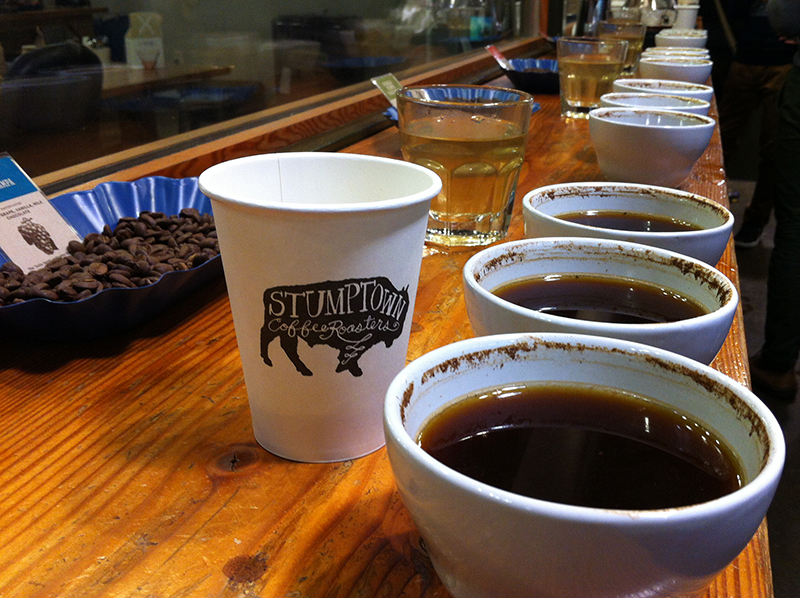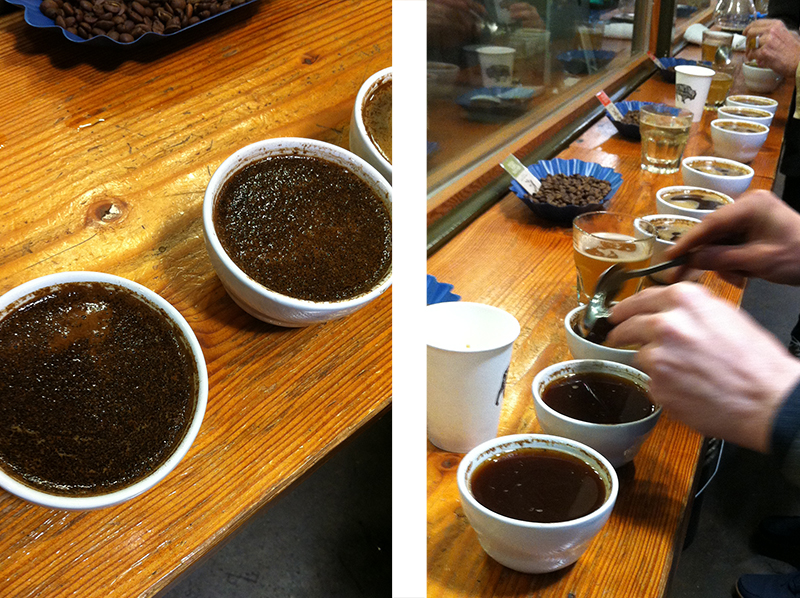
Coffee cupping at Stumptown Coffee Roasters
Last month I spent a long weekend in the undisputed coffee capital of America -- Seattle. Even though I missed the US Coffee Championships by a few days, I still had plenty of opportunities to geek out a little over the region's amazing coffee culture. I typically make up the tea-focused half of Team Caffeine here at the Cambridge shop, but that doesn't mean I don't love coffee, and after sampling the brews of some small, local roasters I was thrilled to stop by the Seattle hub of a Formaggio Kitchen favorite -- Portland-Oregon-based Stumptown Coffee Roasters.
Stumptown has been a major driver of the third-wave craft coffee movement across the U.S. -- that push to relate coffee to the world of wine, bringing single origin terroir, small batch fresh roasting and grower-roaster relationships to the fore of coffee consumption. Stumptown is a massive player in U.S. specialty coffee, and for good reason. Their success has allowed them to develop robust systems for consistency and quality across production. We get our Stumptown coffees from their Brooklyn roastery, but they also have roasteries in Los Angeles, Seattle, and back home in Portland.
Serendipitously, I arrived at their Seattle roastery and cafe just in time for it's weekly coffee cupping -- my first formal coffee tasting, and a free chance to taste through four of Stumptown's most popular single origin coffees! We tasted four coffees: Ethiopia Yirgacheffe Chelbessa, Peru Churupampa, Indonesia Sulawesi Toaco Toraja, and Rwanda Huye Mountain.
Cuppings follow an internationally agreed upon structure (or so I was told by the Turkish baristas I met who were in town for the US Coffee Championships!). It's a four step process, with each step done three separate times to make sure you fully experience the flavor.
First you grind enough of each coffee for three small cups and smell the 'dry fragrance.' The scent of the grinds won't typically be as strong as notes you get in brewed coffee, but it gives you a good foundation as your brain starts building a profile of each one.
Next you pour hot water over the grinds and smell the 'wet fragrance' as it steeps (pardon my tea parlance), in this case for ~4 minutes. The wet fragrance should be stronger than the dry fragrance. For me, while the grinds mostly smelled like coffee, the wet fragrance is where I really started to notice the difference between citrus, floral, and earthy notes. These aromas are important because they blend with the taste-receptor reactions on your tongue to create the full flavor experience of the coffee when you drink it.
As the coffee brews, a foamy layer of coffee grinds forms on the top of the cup, something I immediately recognize from my use of a French press at home. This layer traps aromatic compounds released from the beans as they brew, and using a spoon to gently break the surface gives you an explosion of aromas unique to each coffee. This is where many of the coffee's strongest notes come out.

Left: A view of the layer of grinds trapping aromatic compounds beneath the surface; Right: After breaking the layer on the surface, going back through and tasting each coffee. Note the three cups per varietal! Be sure to taste every cup to give yourself a fuller experience of each coffee.
Finally, after carefully observing all these layers of aroma, it's time to taste! Typically you only taste one tiny spoonful at a time. As is often the case with wine (and with tea), tasting coffee is all about the slurp. Aerating the liquid in your mouth releases more aromas and flavors, so slurping off the spoon is an important step. Also like wine, most tasters spit their sip out, giving you a little more aeration and helping make sure the liquid hits all parts of your tongue so you don't miss any flavors.
In general, Latin American coffees are said to be more evenly balanced and more chocolaty, Indonesian coffees, which are typically only half washed during post harvest processing, have more earthy fermenty notes, and East African coffees (made where coffee was originally cultivated) are the most light, citrusy, and floral -- sometimes almost tea like -- with jasmine, bergamot, or muscatel. I found those distinctions to be pretty true, and maybe it's just because I'm easily influenced, but I really could taste many of the notes on Stumptown's flavor-profile cards (hibiscus vs. lemon, milk chocolate vs. vanilla, etc. etc.).
If you don't feel like orchestrating your own cupping, here in the Boston area you can hit up two other popular Formaggio Kitchen coffee roasters, George Howell Coffee (whose coffee we brew in house) and Counter Culture for one of their weekly cuppings!
Rob Campbell is a culinary adventurer, world traveler, science geek, and also Tea Buyer at Formaggio Kitchen Cambridge.

